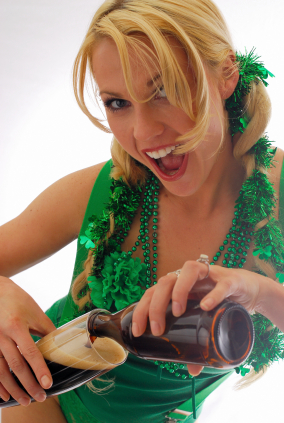Take Mardi Gras, for example - go to any Mardi Gras celebration and 98% of people there will be Protestants, so they haven't fasted for Lent in over 400 years, and 85% won't know why they are getting drunk at all, but they still act like they are getting ready to starve for 40 days - if by starving we mean not having yards of beer for 11 straight hours. It's a real mystery but at least it gets people thinking about religion and its relationship to Brazilian strippers.
A few weeks later, give or take, we have St. Patrick's day, a celebration of a guy who wanted to drive out pagan head dresses, hot wiccan chicks and drunken bacchanalia; really, everything that was great about the Celts. Who in their right mind wants to celebrate that?

Bring back the Celts.
And yet we do. The reasons why are complex but we'd rather light a candle than curse your darkness, and since we were too busy getting drunk during Mardi Gras to write about that, we will delve into this whole St. Patrick thing. Maybe that can also tell us why so many people who don't give a hoot about religion feel a need to get drunk to celebrate a saint because, ladies, as sure as I am sitting here, if a man spills beer on your shoes this March 17th and slurs "Hey, I like you", he is unlikely to be a Deacon at your local church.
The problem with learning about St. Patrick? Like everything else in early history, there's no way to separate fact from fantasy - 1500 years of drunken fables haven't helped and we only have two short documents from him; his own Confession and a "Letter to Coroticus" he wrote, basically to excommunicate some poor bastard. So here is what we do know, mixed in with what we think we know. Anything else is probably made up, so use sparingly.
1) Birth place. St. Patrick was born in Britain around 400 AD - you should plus or minus 10 years on that. His family was likely wealthy, since he was kidnapped by Celtic raiders from Ireland and kept in Ireland for 6 years and they didn't bother to raid the estates of peasants, since peasants didn't actually have estates, no matter what you may have been told lately about how economics works. Anyway, he was kidnapped and held for 6 years. Want to start a fight in Ireland? Go to Mount Slemish in County Antrim and state with authority St. Patrick was instead held in County Mayo near Killala. Or vice versa. Hilarity ensues. Be sure to duck.
2) Visions. According to his writing, St. Patrick had a religious dream telling him to leave Ireland. So he walked 200 miles to the coast and then went back to England. Who knew escape was so easy? Once safely back in England he had another dream telling him to return to Ireland. This was the first recorded instance of an Irishman wondering if God was having a laugh at his expense.
3) Christian conversion of the Irish. He certainly did this but he was a sneaky devil about it. Since the Celts liked bonfires, he made part of the Easter celebration a Paschal Fire; still a Christian ceremony but all bright and pretty like the Irish want. Since they liked the sun, he stuck it on a cross and made it a Celtic cross. He also had to be tough as nails. These Druids were not giving up their culture (paragraph 2 above) lightly, and with good reason.
4) Did he ...? (a) Raise the dead? Who knows? If you listen to the classic Irish tune Finnegan's Wake, or have ever seen "The Princess Bride", you know sometimes people can be only mostly dead. (b) Chase the snakes out of Ireland? There weren't any snakes in Ireland, of the native kind anyway, but the Druids liked snakes so this is more of a metaphor for getting rid of Druidic nature-based paganism. (c) Use the shamrock to explain the Trinity? Okay, that is probably true - three components that make up one plant seem pretty reasonable and it isn't like there were no shamrocks 1600 years ago.
5) Since it is an official Feast Day and you can't sacrifice, what happens if St. Patrick's Day falls on a Friday during Lent? That's a tricky one. The local Bishop can allow meat on a Friday in that instance but in 2008 it was even trickier - St. Patrick's Day fell into Holy Week, the sacred seven days preceding Easter, so there could be no Mass in honor of the saint. What did they do? They moved St. Patrick's Day (the real one) to March 14th. Most Americans didn't notice and still got drunk on the 17th. Luckily that won't happen again until 2160. I know how people hate to get drunk on the wrong day.
6) Why green? The hottest women there have red hair and that's the only decent beer too so why not red? Green for St. Patrick is recent, at least for an old country like Ireland; since the mid 1700s or so. St. Patrick's color was blue. But people associate Ireland with shamrocks and shamrocks were worn for Irish pride so, basically, they chose green just because.
I think red would also be a good way to go, don't you?

Red hair, red beer. R. Leigh may even have the name "Red", we don't know.
That would be awesome.
7) Why is it such a big event in America? There are 9X as many American citizens claiming to be Irish as there are actual citizens of Ireland, that's why. Are you going to argue with 36 million drunk people over whether or not they are actually still Irish if their family has been here since 1840? Ireland sure isn't. Me either.
8) Why parades? No one knows the origin of this strange ritual. While over 100 St. Patrick's Day parades will take place around the United States this year, we know the first one took place in New York City on March 17, 1762, courtesy of the English army on a march through town. It was also the first recorded instance of an Irishman on American soil muttering "feckin' jaysus" and then head-butting one of his countrymen.
So how will you celebrate St. Patrick's Day? Here are some suggestions:
Get cultured. Maxim magazine is always a good place to start.

“Lass call” … bwa ha ha. Click the image to see the larger size.
Go attend a traditional sporting event, like basketball. The Boston team has a few interesting nods to ancient ways. Here is an Irish girl keeping her ancient culture alive by engaging in some sort of Celtic dance ritual done by her ancestors.

However you choose to spend your holiday, be sure and let me know.
References:
"The St. Patrick You Never Knew", By Anita McSorley, St. Anthony Messenger, March 1997
Ireland Now - History of St. Patrick





Comments